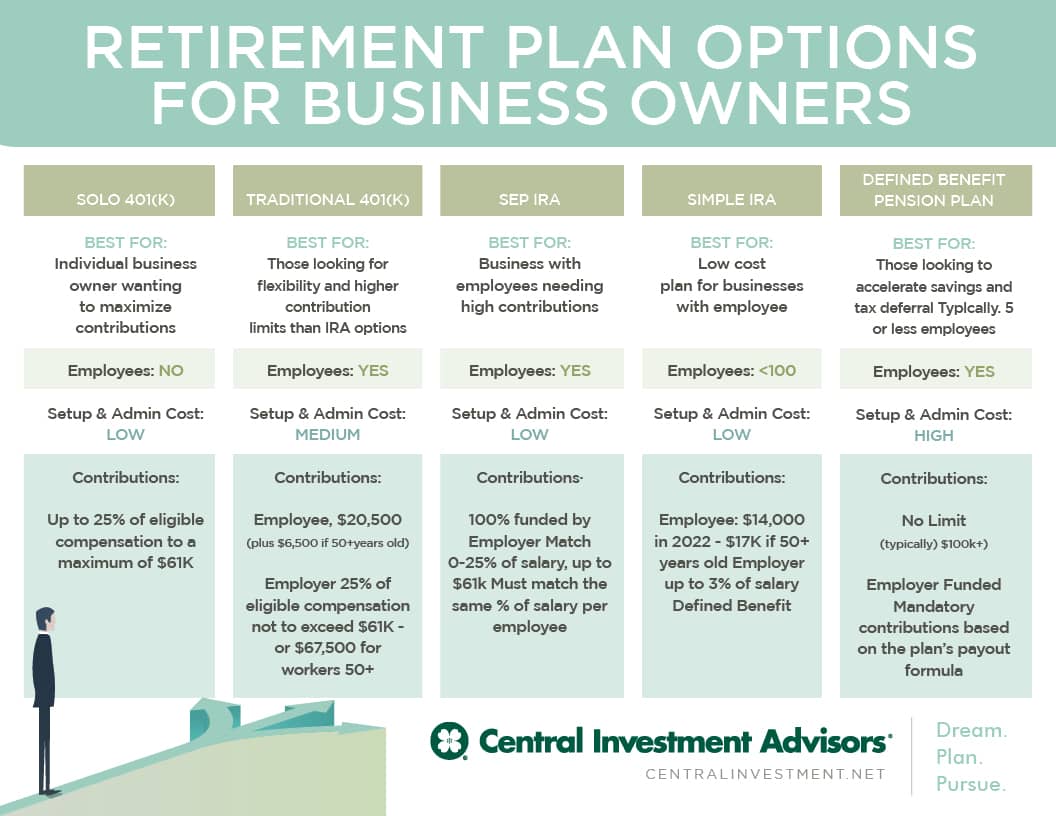
If you are self-employed or own a small business and you haven't established a retirement savings plan, what are you waiting for? A retirement plan can help you and your employees save for the future.
Tax advantages
A retirement plan can have significant tax advantages:
• Your contributions are deductible when made
• Your contributions aren't taxed to an employee until distributed from the plan
• Money in the retirement program grows tax deferred (or, in the case of Roth accounts, potentially tax free)
Types of plans
Retirement plans are usually either IRA-based (like SEPs and SIMPLE IRAs) or "qualified" [like 401(k)s, profit-sharing plans, and defined benefit plans].
Qualified plans are generally more complicated and expensive to maintain than IRA-based plans because they have to comply with specific Internal Revenue Code and ERISA (the Employee Retirement Income Security Act of 1974) requirements in order to qualify for their tax benefits. Also, qualified plan assets must be held either in trust or by an insurance company. With IRA-based plans, your employees own (i.e., "vest" in) your contributions immediately. With qualified plans, you can generally require that your employees work a certain numbers of years before they vest.
Which plan is right for you?
With a dizzying array of retirement plans to choose from, each with unique advantages and disadvantages, you'll need to clearly define your goals before attempting to choose a plan. For example, do you want:
• To maximize the amount you can save for your own retirement?
• A plan funded by employer contributions? By employee contributions? Both?
• A plan that allows you and your employees to make pre-tax and/or Roth contributions?
• The flexibility to skip employer contributions in some years?
• A plan with lowest costs? Easiest administration?
The answers to these questions can help guide you and your retirement professional to the plan (or combination of plans) most appropriate for you.

SEP-IRA
A SEP-IRA allows you to set up an IRA for yourself and each of your eligible employees. SEPs have a low start-up and operating costs and can be established using an easy two-page form. The plan must cover any employee aged 21 or older who has worked for you for three of the last five years and who earns $600 or more.
Employer Contribution Limits
- Employers can contribute up to 25% of the employee’s total compensation or a maximum of $61,000 for the 2022 tax year, whichever is the lesser amount.
- Contributions are limited to 20% of your net income for self-employed individuals.
- Contributions are tax deductible and are not required every year.
- Contributions must be the same for employees and employers up to the specified limit.
Employee Contribution Limits
- Employees cannot defer their salary to make contributions to a SEP-IRA. They may be able to make traditional IRA contributions to the SEP-IRA of up to $6,000 ($7,000 for employees age 50 or older) for the 2022 tax year.
SIMPLE IRA plan
The SIMPLE IRA plan is available if you have 100 or fewer employees. Each employee who earned $5,000 or more in any two prior years, and who is expected to earn at least $5,000 in the current year, must be allowed to participate in the plan.
Employer Contribution Limits
Option 1 - Dollar-for-dollar match of your employee’s contributions of up to 3% of each employee’s compensation. The 3% match can be reduced to 1% in any two of five years.
Option 2 - A fixed 2% contribution of each employee’s compensation. The maximum compensation used to determine this is $305,000 for 2022. Contributions are tax-deductible and are required every year.
Employee Contribution Limits
Employees can contribution up to $14,000 for the 2022 tax year for employees under 50 years of age. For those employees ages 50 and older, the contribution limits are $17,000 for the 2022 tax year.
Profit-sharing plan
Typically, only you, not your employees, contribute to a qualified profit-sharing plan. Your contributions are 401(k) plans are required to perform somewhat complicated testing each year to make sure benefits aren't disproportionately weighted toward higher paid employees. However, you don't have to perform discrimination testing if you adopt a "safe harbor" 401(k) plan. With a safe harbor 401(k) plan, you generally have to either match your employees' contributions (100% of employee deferrals up to 3% of compensation, and 50% of deferrals between 3% discretionary — there's usually no set amount you need and 5% of compensation), or make a fixed to contribute each year, and you have the flexibility to contribute nothing at all in a given year if you so choose (although your contributions must be nondiscriminatory, and "substantial and recurring," for your plan to remain qualified).
The plan must contain a formula for determining how your contributions are allocated among plan participants. A separate account is established for each participant that holds your contributions and any investment gains or losses. Generally, each employee with a year of service is eligible to participate (although you can require two years of service if your contributions are immediately vested). Contributions for any employee in 2022 can't exceed the lesser of $61,000 or 100% of the employee's compensation (up from $58,000 in 2021).
401(k) plan
The 401(k) plan (technically, a qualified profit-sharing plan with a cash or deferred feature) is a popular retirement savings vehicle for small businesses. With a 401(k) plan, employees can make pre-tax and/or Roth contributions in 2022 of up to $20,500 of pay ($27,000 if age 50 or older; up from $19,500 and $26,000, respectively, in 2021). These deferrals go into a separate account for each employee and aren't taxed until distributed. Generally, each employee with a year of service must be allowed to contribute to the plan.
You can also make employer contributions to your 401(k) plan — either matching contributions or discretionary profit-sharing contributions. Combined employer and employee contributions for any employee in 2022 can't exceed the lesser of $61,000 (plus catch-up contributions of up to $6,500 if your employee is age 50 or older; up from $58,000 and $6,500, respectively, in 2021) or 100% of the employee's compensation. In general, each employee with a year of service is eligible to receive employer contributions, but you can require two years of service if your contributions are immediately vested.
401(k) plans are required to perform somewhat complicated testing each year to make sure benefits aren't disproportionately weighted toward higher paid employees. However, you don't have to perform discrimination testing if you adopt a "safe harbor" 401(k) plan. With a safe harbor 401(k) plan, you generally have to either match your employees' contributions (100% of employee deferrals up to 3% of compensation, and 50% of deferrals between 3% and 5% of compensation), or make a fixed contribution of 3% of the compensation for all eligible employees, regardless of whether they contribute to the plan. Your contributions must be fully vested.
Another way to avoid discrimination testing is by adopting a SIMPLE 401(k) plan. These plans are similar to SIMPLE IRAs, but can also allow loans and Roth contributions. Because they're still qualified plans (and therefore more complicated than SIMPLE IRAs), and allow less deferrals than traditional 401(k)s, SIMPLE 401(k)s haven't become popular.
Defined benefit plan
A defined benefit plan is a qualified retirement plan that guarantees your employees a specified level of benefits at retirement (for example, an annual benefit equal to 30% of final average pay). As the name suggests, it's the retirement benefit that's defined, not the level of contributions to the plan. In 2022, a defined benefit plan can provide an annual benefit of up to $245,000 (or 100% of pay if less), up from $230,000 in 2021. The services of an actuary are generally needed to determine the annual contributions that you must make to the plan to fund the promised benefit. Your contributions may vary from year to year, depending on the performance of plan investments and other factors.
In general, defined benefit plans are too costly and too complex for most small businesses. However, because they can provide the largest benefit of any retirement plan, and therefore allow the largest deductible employer contribution, defined benefit plans can be attractive to businesses that have a small group of highly compensated owners who are seeking to contribute as much money as possible on a tax-deferred basis.
As an employer, you have an important role to play in helping America's workers save. Now is the time to look into retirement plan programs for you and your employees.
If you need help establishing a retirement plan for your small business, please contact us.
The opinions voiced in this material are for general information only and are not intended to provide specific advice or recommendations for any individual. To determine which investment(s) may be appropriate for you, consult your financial advisor prior to investing. All performance referenced is historical and is no guarantee of future results. All indices are unmanaged and cannot be invested into directly.
The information provided is not intended to be a substitute for specific individualized tax planning or legal advice. We suggest that you consult with a qualified tax or legal advisor.
LPL Financial Representatives offer access to Trust Services through The Private Trust Company N.A., an affiliate of LPL Financial.
The information provided in these articles is intended for informational purposes only. It is not to be construed as the opinion of Central Bancompany, Inc., and/or its subsidiaries and does not imply endorsement or support of any of the mentioned information, products, services, or providers. All information presented is without any representation, guaranty, or warranty regarding the accuracy, relevance, or completeness of the information.
Category: Retirement
